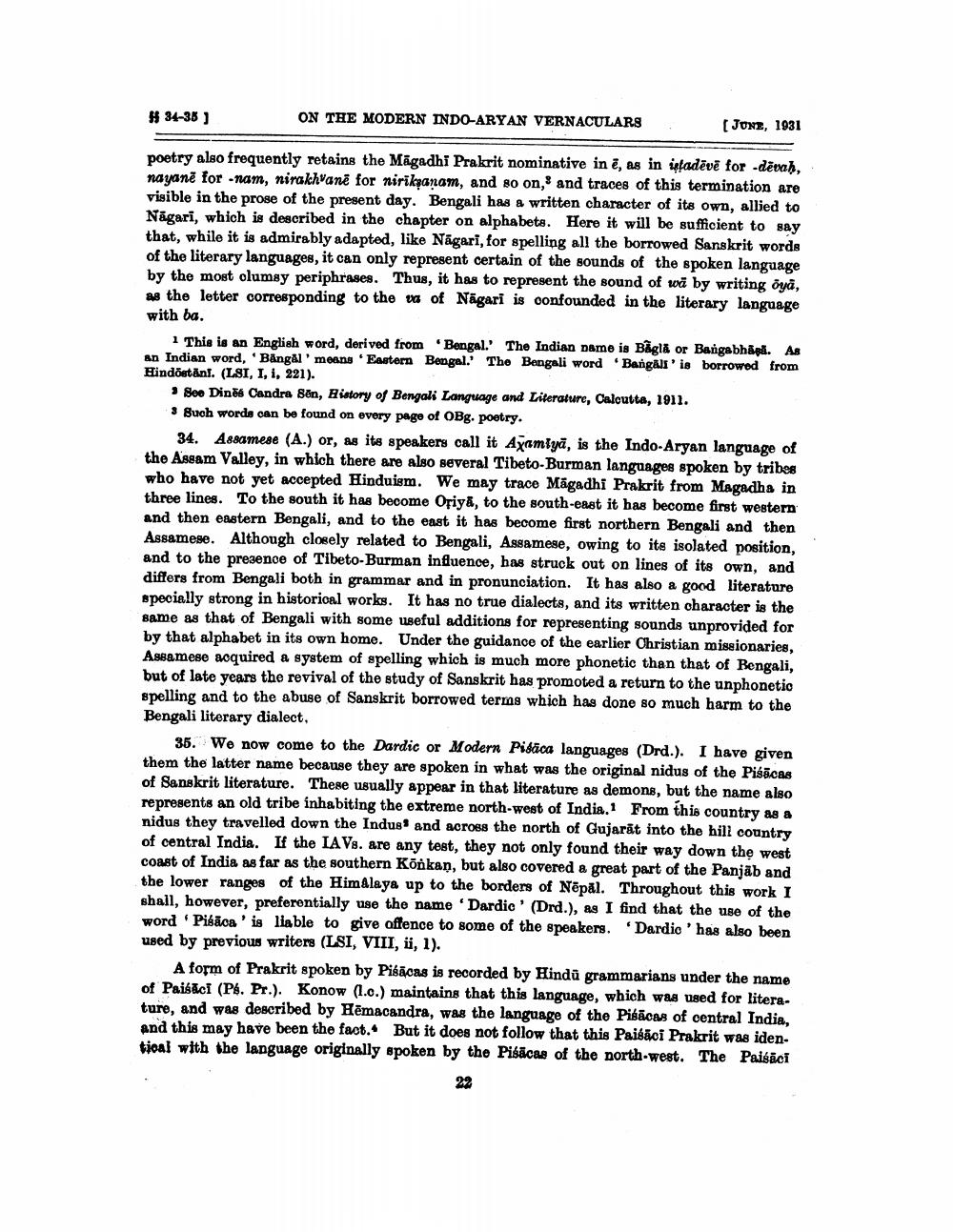________________
# 34-35 )
ON THE MODERN INDO-ARYAN VERNACULARS
(JUNE, 1931
poetry also frequently retains the Māgadhi Prakrit nominative in Z, as in ifadēvē for dēvah, nayanë for-nam, nirakhanë for nirikşaram, and so on, and traces of this termination are visible in the prose of the present day. Bengali has a written character of its own, allied to Nagari, which is described in the chapter on alphabets. Here it will be sufficient to say that, while it is admirably adapted, like Nagari, for spelling all the borrowed Sanskrit words of the literary languages, it can only represent certain of the sounds of the spoken language by the most olumsy periphrases. Thus, it has to represent the sound of wi by writing oya, ng the letter corresponding to the va of Nāgari is confounded in the literary language with ba.
1 This is an English word, derived from Bengal. The Indian name is Bâgla or Bangabhápå. As an Indian word, 'Bangal' means 'Eastern Bengal.' The Bengali word 'Bangali' is borrowed from Hindõstån. (LSI, I, I, 221).
* See Dines Candra &n, History of Bengali Language and Literature, Calcutta, 1911. 3 Buch words can be found on every page of OBg. poetry.
34. Assamese (A.) or, as its speakers call it Aynmlyä, is the Indo-Aryan language of the Asgam Valley, in which there are also several Tibeto-Burman languages spoken by tribes who have not yet accepted Hinduism. We may trace Magadhi Prakrit from Magadha in three lines. To the south it has become Oriya, to the south-east it has become first western and then eastern Bengali, and to the east it has become first northern Bengali and then Assamese. Although closely related to Bengali, Assamese, owing to its isolated position, and to the presence of Tibeto-Burman influence, has struck out on lines of its own, and differs from Bengali both in grammar and in pronunciation. It has also a good literature specially strong in historical works. It has no true dialects, and its written character is the same as that of Bengali with some useful additions for representing sounds unprovided for by that alphabet in its own home. Under the guidance of the earlier Christian missionaries, Assamese acquired a system of spelling which is much more phonetic than that of Bengali, but of late years the revival of the study of Sanskrit has promoted a return to the unphonetic spelling and to the abuse of Sanskrit borrowed terms which has done so much harm to the Bengali literary dialect,
35. We now come to the Dardic or Modern Pisāca languages (Drd.). I have given them the latter name because they are spoken in what was the original nidus of the Piśācas of Sanskrit literature. These usually appear in that literature as demons, but the name also represents an old tribe inhabiting the extreme north-west of India. 1 From this country as a nidus they travelled down the Indus! and across the north of Gujarat into the hill country of central India. If the IAVs. are any test, they not only found their way down the west coast of India as far as the southern Konkan, but also covered a great part of the Panjab and the lower ranges of the Himalaya up to the borders of Nēpal. Throughout this work I shall, however, preferentially use the name 'Dardio' (Drd.), as I find that the use of the word Pilaoa' is liable to give offence to some of the speakers. Dardio' has also been used by previous writers (LSI, VIII, 4, 1).
A form of Prakrit spoken by Pisācas is recorded by Hindu grammarians under the name of Paisāci (Ps. Pr.). Konow (1.c.) maintains that this language, which was used for literature, and was described by Hēmacandra, was the language of the Pisācas of central India, and this may have been the fact. But it does not follow that this Paisāci Prakrit was identioal with the language originally spoken by the Pisācag of the north-west. The Paisāci
222




